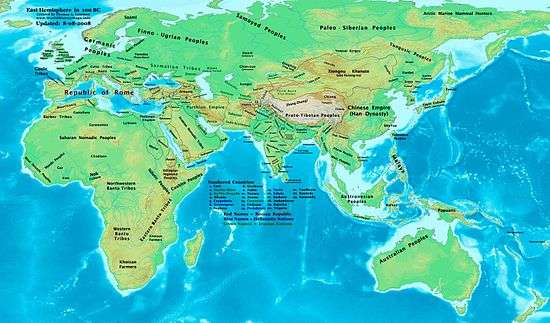List of sovereign states in the 2nd century BC
The development of states—large-scale, populous, politically centralized, and socially stratified polities/societies governed by powerful rulers—marks one of the major milestones in the evolution of human societies. Archaeologists often distinguish between primary (or pristine) states and secondary states. Primary states evolved independently through largely internal developmental processes rather than through the influence of any other pre-existing state. The earliest known primary states appeared in Mesopatamia ca. 3700 B.C., in Egypt ca. 3300 B.C., in the Indus Valley ca. 2500 B.C., India ca 1700 B. C.,and in China ca. 1600 B.C. As they interacted with their less developed neighbors through trade, warfare, migration, and more generalized ideological influences, the primary states directly or indirectly fostered the emergence of secondary states in surrounding areas, for example, the Hittites in Anatolia, the Minoan and Mycenaean states of the Aegean, or the Nubian kingdoms in the Sudan. According to Professor Gil Stein of the University of Chicago Oriental Institute, "The excavations and archaeological surveys of the last few decades have vastly increased both the quantity and quality of what we know about ancient states and urbanism. Archaeologists have broadened the scope of their research beyond the traditional focus on rulers and urban elites. Current research now aims at understanding the role of urban commoners, craft specialists, and village-based farmers in the overall organization of ancient states and societies. Given the immense geographical scope encompassed by the term 'the Ancient World'".[1] The notion of a sovereign state arises in the 16th century with the development of modern diplomacy. For earlier times, the term "sovereign state" is an anachronism. What corresponded to sovereign states in the medieval and ancient period were monarchs ruling by the grace of God, de facto feudal or imperial autocrats, or de facto independent nations or tribal confederations.
This is a list of sovereign states that existed between 200 BC and 101 BC.
Sovereign states

| Sovereign state | Years |
|---|---|
| Adena culture | 1000 - 200 BC |
| Albania | 4th century BC - 8th century AD |
| Ardiaean Kingdom | c.260 – 168 BC |
| Armenia | 190 BC - 428 AD |
| Atropatene | 320s BC - 3rd century AD |
| Bithynia | 297 - 74 BC |
| Buyeo | 2nd century BC - 494 AD |
| Carthaginian Empire | 650 - 146 BC |
| Chavín culture | 900 - 200 BC |
| Chera Kingdom | 5th century BC - 1102 AD |
| Commagene | 163 BC - 72 AD |
| Dardanian Kingdom | c.448 – 28 BC |
| Dongye | 3rd century BC - 5th century AD |
| Gojoseon | 2333 - 108 BC |
| Greco-Bactrian Kingdom | 256 - 125 BC |
| Han Empire | 206 BC - 220 AD |
| Iberia | 302 BC - 580 AD |
| Indo–Greek Kingdom | 180 BC - 10 AD |
| Indo–Scythian Kingdom | 200 BC - 400 AD |
| Japan | 660 BC - present |
| Jin State | 3rd century - 2nd century BC |
| Judea | 137 - 37 BC |
| Kush | 1070 BC - 350 AD |
| Lycaonia | 8th century - 200 BC |
| Macedonia | 8th century - 146 BC |
| Mauretania | 110 BC - 40 AD |
| Maurya Empire | 321 - 185 BC |
| Maya civilization | c.2000 BC - 1697 AD |
| Minyue | 224 - 110 BC |
| Nabataean kingdom | 168 BC - 106 AD |
| Numidia | 202 - 46 BC |
| Okjeo | 2nd century BC - 5th century AD |
| Osroene | 132 BC - 244 AD |
| Paracas culture | 600 - 175 BC |
| Parthian Empire | 247 BC - 224 AD |
| Pontus | 291 BC - 62 AD |
| Ptolemaic Kingdom | 305 - 30 BC |
| Roman Republic | 509 – 27 BC |
| Sātavāhana Empire | 230 BC - 220 AD |
| Scythia | 8th century BC - 2nd century AD |
| Seleucid Empire | 312 - 63 BC |
| Sparta | 11th century - 195 BC |
| Scordisci | c.278 - 50 BC |
See also
- List of Bronze Age states
- List of Iron Age states
- List of Classical Age states
- List of states during Late Antiquity
- List of states during the Middle Ages
| List of sovereign states in the 2nd century BC | ||
| Preceded by 3rd century BC |
Sovereign states of the 2nd century BC |
Succeeded by 1st century BC |
References
- ↑ Stein, Gil J (2001). Understanding Ancient State Societies in the Old World. New York: Kluwer Academic/Plenum Press. pp. 353–379.